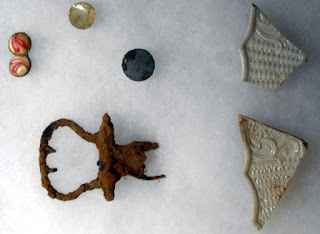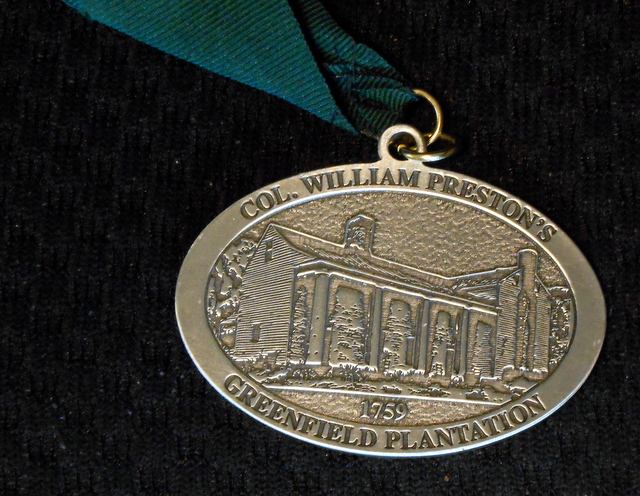The Botetourt Board of Supervisors this week moved the historic structures at Greenfield from their original location to the little historic "park" they have been planning to build for the last 20 years. Articles and video of the move can be seen at these links:
http://wtvr.com/2016/02/25/this-is-living-history-says-group-fighting-to-keep-historic-slave-homes-in-place/
http://www.roanoke.com/news/local/botetourt_county/relocation-of-historic-slave-buildings-in-botetourt-county-completed/article_02979c67-174e-5c8e-bfad-78317f0d141e.html#.VtASBDlPKcg.facebook
http://www.wdbj7.com/news/local/second-greenfield-slave-home-moved-to-new-location/38195702
http://wsls.com/ap/relocation-of-2-historic-slave-buildings-completed/
http://wsls.com/2016/02/26/botetourt-historic-slave-kitchen-moved-county-board-responds-to-complaints/
Below are the last photos I took of the structures while they were still on the hill. In these pictures, the integrity of the structures was already compromised, and had been since about mid-December, at least from a historian's point of view. I am not a historian but I know that when you raise a building off its foundation, it's not the way it was before it was moved. That is when I stopped writing letters to the editor, asking the supervisors to slow down their plans, because I knew the cause was lost. You can read those two letters here, and here. I don't believe they were incendiary or otherwise inappropriate.
My concern now is not these structures. They are moved, the deed is done, the county is moving forward with what it wants regardless of public outcry. I will support whatever happens next, just like I did when the county purchased Greenfield initially even though I objected to that 20 years ago.
If you want one supervisor's take on the issue, you can read his responses to some questions from a retired journalist at the blog, fromtheeditr. The supervisor in his comments is rather unhappy with those who attempted to keep these structures intact and in place, calling them "white radical historical preservationist [who] played the race card," and "arm chair white intelligentsia" and saying "Everybody loves a messy story, especially if someone screams unresponsive big government and racist. I confess to being a little surprised at the single-minded unrelenting opposition of a talented small minority."
I'll let you make your own judgment about what that says about the supervisor, and you can read the rest of his comments for yourself at the link.
What I want now is for everyone to take a deep breath and play nice. There have been multiple letters to the editor about this issue, but I did not perceive any of them to be mean, more like a pleading for the supervisors to stop and think that there might be other ways to accomplish the same goals. I do not know what conversations have been held in private, between individuals. I've been sick the whole month of February, so I have no idea what rumors have been spread.
What I do know is that the supervisors moved forward and never actually had a dialogue with the public about this issue. Listening to someone speak for three minutes and then thanking them, without engaging in a conversation, is not dialogue. Whatever happened 20 years ago doesn't count, either. That was a generation ago.
In my letter to the editor early when the story broke back in October (I wasn't writing for any paper then, so felt free to do that), I suggested the supervisors slow down to give the public more time to digest this project. They did not. They held one open meeting in late October, and it did not go well.
I wish the supervisors had then set up a public information session to better explain themselves, but they did not, and their lack of communication has been perceived as pigheadedness. I know it frustrated me, as someone who had sat in their meetings for two years and knew that something wasn't right here. The secretiveness felt wrong.
They forgot that nothing has been done to Greenfield in 15 years except for recreational fields, the sports complex, and the Cherry Blossom trail. This 20-year-old bond referendum the supervisors have referenced on occasion means nothing to anybody younger than 45. Many people who have moved to Botetourt did not even know Greenfield was an industrial park. Of course this move to relocate historic structures surprised those folks. They considered it a county park, not an industrial ground.
I initially supported the "talented minority," but backed off in early February. I felt that some of their rhetoric seemed out of control and as a (former) news reporter I refused to be a part of that. I was asked to be involved initially but my involvement was peripheral (I created the initial Facebook page because no one else knew how). The leaders of the "talented minority" asked no more of me and I did not volunteer more. By early February, I was out of it entirely. I did not attend a single one of their meetings. I do not know if any of the supervisors think I was a part of that, but I was not.
I remain disappointed in the board's lack of communication with the public, and I feel the supervisor's response at the fromtheeditr blog were somewhat slippery. I think many people wanted a public dialogue, and the supervisors refused to do that. That allowed the opposition to make a lot of noise, so the supervisors hold some blame for this negative publicity for Botetourt. My opinion, of course. I suppose I am one of those "arm chair intelligentsia" people.
Some of the statements in the fromtheeditr blog are not exactly true - in 2006 I wrote an article for the local paper and the structures ended up on the national register of endangered places as a result. These structures were county-owned and county officials had promised to care for them, one way or the other, so why should the historical societies have thought otherwise, or stepped in? The county did not ask for their help, and had long ago indicated they would take the lead on restoration. In 2006 the county did take some steps to shore up the structures after they were placed on the endangered list. They did not ask for help from the historical societies then, either, that I am aware of.
In 2012 the supervisors at that time, which included three different men, informally promised that these structures would be left on the hill top. I was at the meetings when they discussed it. However, they never made a resolution to that point. Many preservationists, though, thought that their comments were an official decision. So that is why, when word got out in October that these buildings would be removed and the hill leveled, people were surprised. Three years ago they had been promised otherwise, in their mind.
Regarding the "race card," I wanted these structures preserved where they were because they were old. Anything pre-Civil War deserves to be studied and looked at before it is bulldozed or torn down or moved or whatever. These were on public property and there had been no hurry for 20 years. It made no difference to me if they were slave quarters or a settler's shack. I just knew they were old and relevant to historical studies. I didn't see why another six months mattered. That would have been time for a more thorough archeological look.
Personally, I do not know if slaves are buried near the manor house. They could have been buried a good 30-minute walk away on a 3,000 acre plantation (which it was in the late 1700s - early 1800s). Those graves may have been bulldozed over when the county built the sports complex for all we know. The historic park should have a little monument to "unknown people who may have been buried on these grounds" or something.
The hill itself has significance because it has terraced Jeffersonian gardens on it. There may be heirloom plants there. It should be studied before the dirt is carted off. I doubt it will be.
Regardless of how the supervisors feel about this, as leaders I do think it is their responsibility now to mitigate this issue and create a better sense of harmony here between the county and the preservationists.
If they were to ask me (which they won't), I would advise some kind of open information session. The supervisors wouldn't even have to be there - let the county administrator and the deputy county administrator take the heat. Show what this historic "park" could look like, show what the shell building will look like, show what they plan or hope to do with the other 550 acres. I think it would be worth the $10,000 it would take for a few architectural drawings to restore community trust and harmony.
To many, this project seems to have taken place and been decided in secret. Get rid of that perception and it will go a long way to putting Botetourt County back together again.






















































